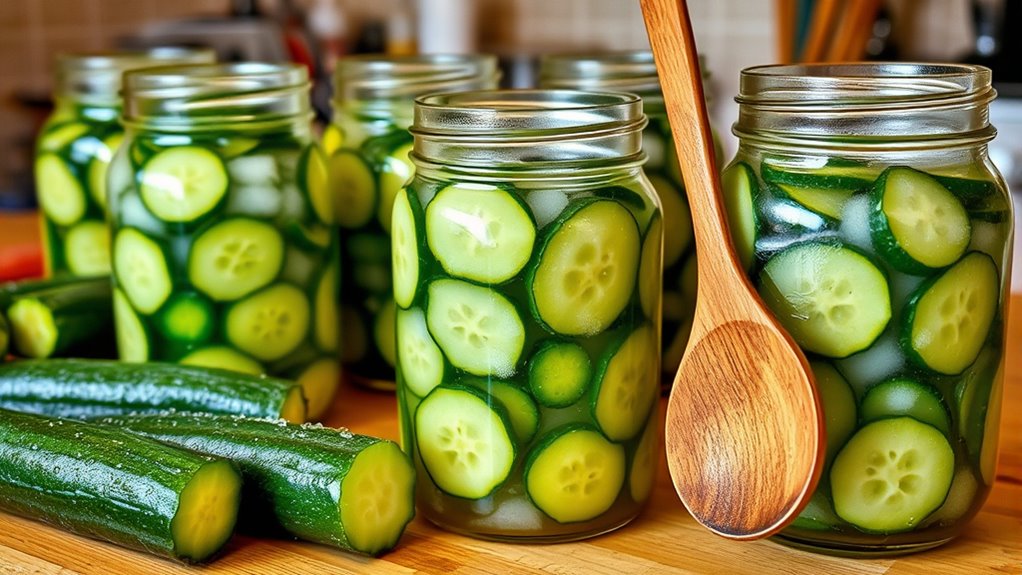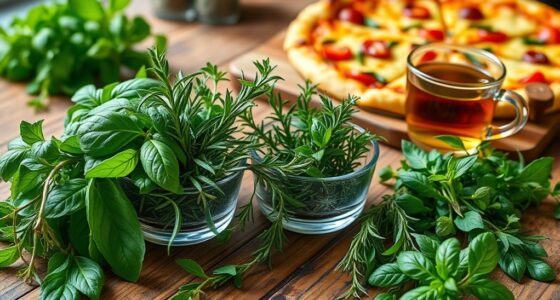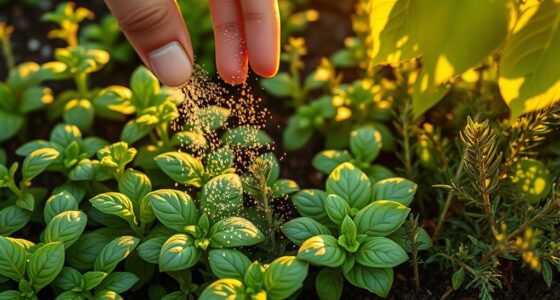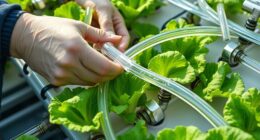To host a pickle party with your indoor cucumber harvest, start by choosing your favorite spices like dill, garlic, or red chili flakes, layering them evenly with your cucumbers in clean jars. Let the jars ferment in a warm, dark spot for 3 to 7 days, tasting periodically until they reach your desired tang and crunch. Once ready, transfer the jars to the fridge to slow fermentation and enjoy your homemade probiotic pickles. Keep exploring to discover more tips for perfect results.
Key Takeaways
- Select fresh, crisp cucumbers and layer them with your preferred spice blend in sterilized jars.
- Use classic spices like dill, garlic, and peppercorns, or experiment with herbs like mustard seeds and chili flakes.
- Ferment at room temperature for 3 to 7 days, tasting periodically to achieve desired sourness and crunch.
- Keep jars out of direct sunlight and monitor the temperature for consistent fermentation conditions.
- Once fermented to your liking, store the pickles in the refrigerator to preserve flavor and texture.

Fermenting cucumbers is a simple and rewarding way to create tangy, probiotic-rich snacks right in your own kitchen. Once you’ve harvested your indoor cucumber crop, you can turn them into delicious fermented pickles that are full of flavor and health benefits. The key to successful fermentation lies in understanding the right spice combinations and fermentation timelines. These elements influence the final taste, texture, and overall quality of your homemade pickles.
When selecting spices, think about classic combinations like dill, garlic, and peppercorns for a traditional flavor. But don’t hesitate to experiment with other herbs and spices—mustard seeds, coriander, or even a touch of red chili flakes can add depth and a personalized touch to your pickles. The goal is to balance the acidity with aromatic spices that complement the cucumbers’ natural crispness. As you prepare your jars, layer your cucumbers with these spice combinations, ensuring each jar gets an even distribution of flavors. This step is vital because it determines the complexity and aroma of your finished product.
Timing is everything when it comes to fermentation. Typically, you’ll want to let your cucumbers ferment at room temperature for about 3 to 7 days. During this period, fermentation timelines can vary depending on temperature and your taste preference. A warmer environment accelerates fermentation, so you might find your pickles ready in fewer days, while cooler spaces require longer. It’s important to start tasting your pickles after three days to check their progress. Use a clean fork or spoon to sample a small piece; if it’s tangy and the texture is crisp to your liking, it’s ready. If not, reseal the jar and let it ferment a few more days, tasting periodically until you achieve the perfect balance of sourness and crunch. Additionally, understanding the fermentation process can help you better control the outcome and ensure safety.
Make sure to keep the jars out of direct sunlight and maintain consistent room temperature to guarantee even fermentation. Once your pickles reach the desired flavor, transfer the jars to the refrigerator to slow down the process. Properly fermented cucumbers can last several weeks, giving you plenty of time to enjoy your homemade snack. Remember, patience is essential—rushing the process can lead to uneven flavors or overly soft pickles. By carefully selecting your spice combinations and monitoring fermentation timelines, you’ll produce crisp, flavorful, probiotic-rich cucumbers that are a perfect addition to any meal or snack.
Frequently Asked Questions
Can I Use Non-Organic Cucumbers for Fermentation?
You can use non-organic cucumbers for fermentation, but consider the non-organic concerns like pesticides or wax coatings that might affect the process. These substances could impact the flavor differences in your fermented pickles or interfere with the beneficial bacteria. To guarantee the best results, wash your cucumbers thoroughly or peel them if you’re worried about residues. Choosing organic cucumbers can help avoid these issues and produce a purer, more flavorful pickle.
How Long Can I Store Fermented Pickles in the Fridge?
Imagine your fridge is like a time capsule, preserving your flavors for days to months. You can store fermented pickles for up to 6 months, but for peak pickling safety and flavor preservation, enjoy them within 3 months. Keep the jars submerged and stored at consistent temperatures. After that, taste and assess their quality—if they develop off-odors or mold, it’s best to discard.
What Are Common Signs of Bad Fermentation?
When checking for bad fermentation, look out for mold detection on the surface or inside your jar, which indicates spoilage. Off odor identification is another key sign; if your pickles smell sour, rotten, or unpleasant, it’s best to discard them. You should also watch for a slimy texture or discoloration. Trust your senses—any unusual signs mean your fermented pickles have gone bad and should be thrown out for safety.
Can I Reuse the Brine for Multiple Batches?
You can reuse brine for fermentation, but it’s important to consider fermentation safety. Reusing brine may introduce unwanted bacteria or mold, risking spoilage. To minimize this, make sure the brine is still salty enough and free of any mold or off-smells. If you notice any signs of spoilage, discard it. For best results, save a small amount of fresh brine or start with new brine to ensure a safe, delicious batch every time.
Are There Variations for Fermenting Other Vegetables?
You can definitely explore variations in vegetable fermentation to create unique flavor profiles. Try fermenting carrots, cauliflower, or radishes to enjoy different textures and tastes. Each vegetable reacts differently, so experiment with spices or herbs to add flavor variations. You’ll find that adjusting fermentation time or adding ingredients like garlic or dill can turn simple vegetable fermentation into a delicious, customized experience tailored to your preferences.
Conclusion
Don’t worry if you’re new to fermenting—it’s simple and rewarding. Imagine biting into crisp, tangy homemade pickles whenever you want, knowing you crafted them yourself. Even if your cucumbers aren’t perfect, fermentation brings out delicious flavors and preserves your harvest. Just give it a try; with a little patience, you’ll enjoy satisfying, crunchy pickles that beat store-bought any day. So, go ahead—turn your indoor cucumber bounty into tasty, probiotic-rich treats!









